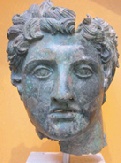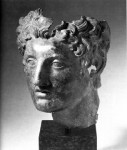

Unknown
Roman
Head of Alexander, 3rd c. CE, first half
bronze
11 ¾ x 10 ½ x 9 in.
SBMA, Bequest of Suzette Morton Davidson
2002.31.2
COMMENTS
This fine head, albeit highly idealized, has been identified as a portrait of Alexander the Great, which to judge by its keen sense of modeling and superb bronze casting, was a worthy tribute to the much revered Macedonian leader who extended Greek culture as far as the borderland of India and present-day Afghanistan. The head can be assigned to the Roman period, most likely created in Asia Minor, primarily on the evidence of the rendering of the eyes--solid with pupils incised rather than inlaid, a technique known for bronze statues of Severan rulers discovered at Kaisereion, Turkey. It should be noted that the eyes for the bronze head of the bearded man also in the SBMA collection were cast along with the head, but its eye detailing, a deep concavity or pit for the pupil, differs markedly from this head of Alexander.
A testimonial to the admiration that Alexander managed to instill though out the classical world is convincingly provided by the countless sculpture portraits of him produced in the Hellenistic world and the Roman Empire long after his death in 323 BCE. The Santa Barbara Head of Alexander dates to Severan times, but more specifically to the reigns of Caracalla and/or Alexander Severus between 211 and 235 BCE.
There are marble heads of Alexander now in Dresden and Vienna which offer close stylistic parallels to this SBMA bronze head.
- Adapted from Maria A. Del Chiaro, Classical Art Sculpture,Santa Barbara Museum of Art, 1984, p. 82
